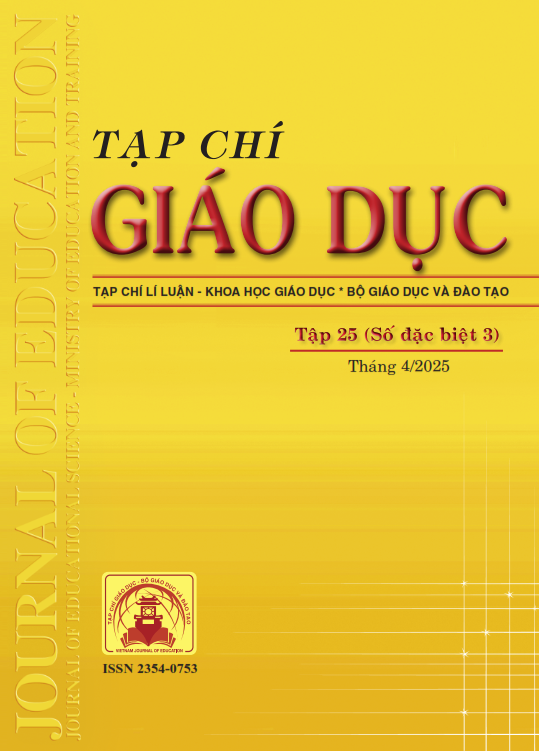Ứng dụng công nghệ 3D trong giảng dạy học phần “Di truyền học” cho sinh viên ngành Sư phạm Khoa học tự nhiên tại Trường Đại học Quảng Bình
- Từ khóa:
- 3D Technology
- genetics
- model
- Natural Science
Tóm tắt
In modern education, 3D technology is an effective tool for enhancing learning experiences, especially in visualization-intensive subjects like Genetics. This study applies 3D technology in teaching Genetics to help students gain a deeper understanding of DNA structure, chromosomes, and genetic mechanisms. Results indicate that 3D models not only improve knowledge accessibility but also stimulate students' enthusiasm for learning. However, the integration of 3D technology presents several challenges, including high implementation costs, technical infrastructure requirements, and the necessity for technological proficiency. Therefore, it is essential to develop strategies for resource optimization, teacher training, and the design of appropriate instructional content to maximize the benefits of this technology. The study recommends integrating 3D technology into natural science curricula to foster critical thinking and creativity, thereby establishing a solid foundation for practical applications and advanced research.
Tài liệu tham khảo
Ausubel, D. P. (1968). A Cognitive view. Educational psychology.
Chistyakov, F. E., & Sumatokhin, S. V. (2019). Virtual reality in education: Pros and cons. Biology in School, 8, 13-16. EDN YMRUUC.
Disterveg, A., & Rotenberg, V. A. (1956). Izbrannye pedagogicheskie sochineniya. M.: Uchpedgiz, 111-112.
Esmakhanova, Z. S. (2023). SV Sumatokhin. Уважаемые читатели!, 46.
Ford, S., & Minshall, T. (2019). Where and how 3D printing is used in teaching and education. https://doi.org/10.17863/CAM.35360
Guseinov, A. Z., & Turchin, G. D. (2007). Development of the principle of visuality in the history of pedagogy. Izvestiya of Saratov University. Philosophy. Psychology. Pedagogy, 7(1), 64.
Hackett, M., & Proctor, M. (2016). Three-dimensional display technologies for anatomical education: a literature review. Journal of Science Education and Technology, 25(4), 641-654. https://doi.org/10.1007/s10956-016-9619-3
Komensky, J. A. (1955). Selected pedagogical works. Uchpedgiz.
Kudryashova, A. M., & Teremov, A. V. (2021). Use of messengers by teachers in the teaching of biology. Problems of Biological and Environmental Education of Schoolchildren and Students, 91-92. EDN TMLGDO.
Nazarova, T. S., Tihomirova, K. M., & Kudina IYu, K. D. (2012). Instrumental'naya didaktika: perspektivnye sredstva, sredy, tekhnologii obucheniya [Instrumental didactics: promising tools, environments, learning technologies]. Moscow, Saint Petersburg.
Petrov, E. E. (2022). Application of 3D modeling in the study of cell structure in a biology elective course. In Biological Education: Traditions and Innovations: Proceedings of the 1st All-Russian Scientific-Practical Conference (pp. 110-114). Chelyabinsk: Southern Ural State Humanities and Pedagogical University.
Petrov, E. E. (2023). On the prerequisites to improve the method of teaching biology using 3D technologies. Education. Science. Scientific Personnel, 3, 225-228. https://doi.org/10.56539/20733305_2023_3_225
Potkonjak, V., Gardner, M., Callaghan, V., Mattila, P., Guetl, C., Petrović, V. M., & Jovanović, K. (2016). Virtual laboratories for education in science, technology, and engineering: A review. Computers & Education, 95, 309-327.
Teremov, A. V., & Pjtunina, S. K. (2022). Modern problems of school biology education in the Russian Federation. In Natural Science and Geographic Education in the Context of Curriculum Renewal and Digital Transformation of the Learning Process: Materials of the All-Russian Scientific-Practical Conference with International Participation (pp. 118-127). Moscow: Printika. EDN JYJQLH.
Teremov, A. V., Galushin, V. M., & Teplov, D. L. (2018). Problems in the use of electronic means in biology education. 21st Century Teacher, 1, 1. https://cyberleninka.ru/article/n/problemy-ispolzovaniya-elektronnyh-sredstv-obucheniya-biologii
Đã Xuất bản
Cách trích dẫn
Số
Chuyên mục
Giấy phép

Tác phẩm này được cấp phép theo Ghi nhận tác giả của Creative Commons Giấy phép quốc tế 4.0 .












